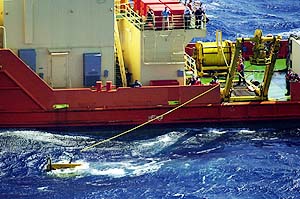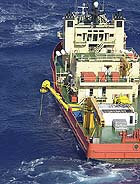 |
| The unmanned submersible vehicle Scorpio, which will be used to search for the Ehime Maru, rode the surface tethered to the mother ship C-Commando before making a dive yesterday.
Associated Press |
 Relatives of those missing want sunken vessel raised Relatives of those missing want sunken vessel raised
 Video of victims' families news conference Video of victims' families news conference
 NTSB investigators use publicity to force changes NTSB investigators use publicity to force changes
 Japanese town leaders demand U.S. apology Japanese town leaders demand U.S. apology
 U.S.-Japan alliance not threatened, says official U.S.-Japan alliance not threatened, says official
 Kaua'i Visitors Bureau makes, accepts donations for families Kaua'i Visitors Bureau makes, accepts donations for families
 Tribute to the Missing Tribute to the Missing
 Previous stories Previous stories
By Dan Nakaso
and David Waite
Advertiser Staff Writers
The fast-attack submarine USS Greeneville had "at least some sonar contacts" with surface vessels before it rose and slammed into a Japanese fishing vessel Feb. 9 off Diamond Head, National Transportation Safety Board investigators confirmed yesterday.
The heart of the NTSB’s investigation lies in figuring out why the Greeneville could not determine there was a ship on the surface before the collision, said John Hammerschmidt, an NTSB member with the investigating team in Hawai‘i.
NTSB investigators are trying to determine the number of other vessels — or "sonar contacts" — that the Greeneville crew tracked and at what point they knew about the contacts before they collided with the Ehime Maru, a ship used to train teenaged fishermen from the Japanese coastal city of Uwajima.
It is not known how many sonar contacts were made and exactly how close to the time of the accident they occurred.
Investigators yesterday said they had finished interviewing a sonar supervisor and a broad band sonar operator and planned to talk to two other sonar operators. An interview was also scheduled with what the Navy refers to as a fire control plotter who also would have been informed about the sonar contacts.
Hammerschmidt declined to be specific about what the sonar operators had to say, noting that he didn’t want to prejudice the accounts of those yet to be interviewed.
 |
| The C-Commando waits on the surface while the Scorpio dives. Its tether is visible on the ship's port side.
Associated Press |
The Greeneville was performing an "emergency main ballast blow" with 16 civilians on board when it crashed into the Ehime Maru, causing it to sink within 10 minutes. Nine of the 35 people on board were still missing last night. The Coast Guard said it would continue its search indefinitely.
In Washington yesterday, the NTSB interviewed four of the sub’s 16 civilian guests. A Hawai‘i Kai couple who were aboard the Greeneville at the time of the accident have not yet been interviewed.
The Navy has said the Greeneville was using its passive sonar at the time of the crash and not the more accurate active sonar, which can give away a submarine’s position. The NTSB had previously said that the sonar and periscopes — the two ways to track for other vessels — were in working order on the Greeneville.
A decade ago, the NTSB issued a safety recommendation that Navy submarines use active sonar when coming to periscope depth — as long as it does not compromise national security interests. The recommendation came after the USS Houston’s communications mast snagged the cable of the tugboat Barcona and pulled it under, killing one man aboard.
Even though the NTSB yesterday did not reveal the exact timing of the Greeneville’s sonar contacts, the fact that technicians had been tracking surface ships nine miles south of Diamond Head is "highly significant," said Jim Bush, a retired Navy captain who commanded the ballistic missile submarine USS Simon Bolivar.
"Good submarining says that before you surface, you make sure there are no ships in the area," Bush said. "If they already had contacts that there might have been ships there, it’s even worse that they surfaced."
Passive sonar can pick up surface ships as far as 50 miles away — on a good day, he said.
Submarine captains would be prudent to execute an emergency ascent only if the nearest surface ship were at least 10 miles away, Bush said. But he wouldn’t do it if there were any ships in the area.
"I would prefer that I had no contacts," Bush said. "Before you do the emergency surface, you try to sanitize the area. You want to make sure that it is almost impossible for a ship to get there by the time it takes you to go down and come back up."
Michael Nahoopii, a Navy Academy graduate who was officer of the deck of the fast-attack sub USS Indianapolis, said sonar technicians should take as much time as necessary to identify any surface contacts.
"It’s more good prudence if suddenly there’s a new player out there," he said. "You want to find out what this guy is doing before you commit to a maneuver that will cause you to lose control."
The officer of the deck, or captain, should have maneuvered the Greeneville several times to pinpoint every ship in the area, he said.
Once the order is given to execute the "main emergency ballast blow," Nahoopii said, "you’re on the way to the surface and there’s nothing going to stop you. You’re on an express train to the surface."
By blowing the ballast tanks and using the sub’s nuclear-powered engines, Bush said, the Greeneville could have reached a maximum speed of 30 knots (about 35 mph) heading toward the surface.
It’s a spectacular move that Bush said would have been unnecessary to impress the 16 civilians on board — including two at the ship’s control stations under the supervision of Navy operators.
"Especially if you’ve got contacts in the area, don’t do it," Bush said. "You can impress your visitors by doing other things."
He said high-speed, 25-knot ascents and descents underwater — Bush called them "angles and dangles" maneuvers — are enough to show off the capabilities of Navy submarines.
Also yesterday:
 Newsday quoted an admiral familiar with the Navy’s investigation as saying that the Ehime Maru was heading toward the Greeneville and presented such a small target that four periscope sweeps could not detect it. Newsday quoted an admiral familiar with the Navy’s investigation as saying that the Ehime Maru was heading toward the Greeneville and presented such a small target that four periscope sweeps could not detect it.
The Ehime Maru’s white bow was too small to see in the 6- to-8-foot swells, the unidentified admiral told Newsday.
 The Navy formally halted emergency surfacing drills with civilians on board and will not allow civilians to operate submarine equipment, at least temporarily. The Navy formally halted emergency surfacing drills with civilians on board and will not allow civilians to operate submarine equipment, at least temporarily.
 Adm. Thomas Fargo, commander of the U.S. Pacific Fleet, received the Navy’s preliminary investigation into the collision. He then canceled plans to hold a press conference about the report. Adm. Thomas Fargo, commander of the U.S. Pacific Fleet, received the Navy’s preliminary investigation into the collision. He then canceled plans to hold a press conference about the report.
At the site of the collision between the Greeneville and the Ehime Maru, technicians yesterday lowered a remotely operated vehicle, the Scorpio II, to try to reach the wreck of the Ehime Maru in 1,800 feet of water.
A team of 26 people from the Underwater Vehicles Detachment of the Deep Submergence Unit in Coronado, Calif., were on board the ship C-Commando that had to be turned away Wednesday because of rough seas. Waves of 6 to 8 feet also temporarily delayed operations yesterday.
The Navy, meanwhile, was preparing the USS Greeneville indefinitely for dry dock at Pearl Harbor to inspect the rudder, propeller and hull for possible repairs.
Dry-docking the Greeneville will mean unloading the sub’s weapons. The Navy declined to discuss whether the Greeneville may have been carrying nuclear weapons when it collided with the Ehime Maru.
[back to top] |



